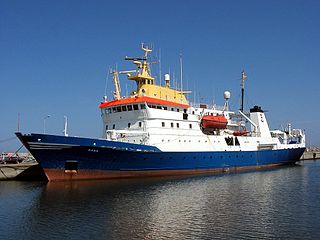Related Research Articles
The carrying capacity of an environment is the maximum population size of a biological species that can be sustained by that specific environment, given the food, habitat, water, and other resources available. The carrying capacity is defined as the environment's maximal load, which in population ecology corresponds to the population equilibrium, when the number of deaths in a population equals the number of births. The effect of carrying capacity on population dynamics is modelled with a logistic function. Carrying capacity is applied to the maximum population an environment can support in ecology, agriculture and fisheries. The term carrying capacity has been applied to a few different processes in the past before finally being applied to population limits in the 1950s. The notion of carrying capacity for humans is covered by the notion of sustainable population.
In population ecology and economics, maximum sustainable yield (MSY) is theoretically, the largest yield that can be taken from a species' stock over an indefinite period. Fundamental to the notion of sustainable harvest, the concept of MSY aims to maintain the population size at the point of maximum growth rate by harvesting the individuals that would normally be added to the population, allowing the population to continue to be productive indefinitely. Under the assumption of logistic growth, resource limitation does not constrain individuals' reproductive rates when populations are small, but because there are few individuals, the overall yield is small. At intermediate population densities, also represented by half the carrying capacity, individuals are able to breed to their maximum rate. At this point, called the maximum sustainable yield, there is a surplus of individuals that can be harvested because growth of the population is at its maximum point due to the large number of reproducing individuals. Above this point, density dependent factors increasingly limit breeding until the population reaches carrying capacity. At this point, there are no surplus individuals to be harvested and yield drops to zero. The maximum sustainable yield is usually higher than the optimum sustainable yield and maximum economic yield.

Overfishing is the removal of a species of fish from a body of water at a rate that the species cannot replenish, resulting in those species becoming underpopulated in that area. Overfishing can occur in water bodies of any sizes, such as ponds, rivers, lakes or oceans, and can result in resource depletion, reduced biological growth rates and low biomass levels. Sustained overfishing can lead to critical depensation, where the fish population is no longer able to sustain itself. Some forms of overfishing, such as the overfishing of sharks, has led to the upset of entire marine ecosystems. Types of overfishing include: Growth overfishing, recruitment overfishing, ecosystem overfishing.
The goal of Fisheries management is to produce sustainable biological, social, and economic benefits from renewable aquatic resources. Fisheries are classified as renewable because the organisms of interest usually produce an annual biological surplus that with judicious management can be harvested without reducing future productivity. Fisheries management employs activities that protect fishery resources so sustainable exploitation is possible, drawing on fisheries science and possibly including the precautionary principle. Modern fisheries management is often referred to as a governmental system of appropriate management rules based on defined objectives and a mix of management means to implement the rules, which are put in place by a system of monitoring control and surveillance. A popular approach is the ecosystem approach to fisheries management. According to the Food and Agriculture Organization of the United Nations (FAO), there are "no clear and generally accepted definitions of fisheries management". However, the working definition used by the FAO and much cited elsewhere is:
The integrated process of information gathering, analysis, planning, consultation, decision-making, allocation of resources and formulation and implementation, with enforcement as necessary, of regulations or rules which govern fisheries activities in order to ensure the continued productivity of the resources and the accomplishment of other fisheries objectives.

Population ecology is a sub-field of ecology that deals with the dynamics of species populations and how these populations interact with the environment, such as birth and death rates, and by immigration and emigration.

Fisheries science is the academic discipline of managing and understanding fisheries. It is a multidisciplinary science, which draws on the disciplines of limnology, oceanography, freshwater biology, marine biology, meteorology, conservation, ecology, population dynamics, economics, statistics, decision analysis, management, and many others in an attempt to provide an integrated picture of fisheries. In some cases new disciplines have emerged, as in the case of bioeconomics and fisheries law. Because fisheries science is such an all-encompassing field, fisheries scientists often use methods from a broad array of academic disciplines. Over the most recent several decades, there have been declines in fish stocks (populations) in many regions along with increasing concern about the impact of intensive fishing on marine and freshwater biodiversity.
Individual fishing quotas (IFQs), also known as "individual transferable quotas" (ITQs), are one kind of catch share, a means by which many governments regulate fishing. The regulator sets a species-specific total allowable catch (TAC), typically by weight and for a given time period. A dedicated portion of the TAC, called quota shares, is then allocated to individuals. Quotas can typically be bought, sold and leased, a feature called transferability. As of 2008, 148 major fisheries around the world had adopted some variant of this approach, along with approximately 100 smaller fisheries in individual countries. Approximately 10% of the marine harvest was managed by ITQs as of 2008. The first countries to adopt individual fishing quotas were the Netherlands, Iceland and Canada in the late 1970s, and the most recent is the United States Scallop General Category IFQ Program in 2010. The first country to adopt individual transferable quotas as a national policy was New Zealand in 1986.

Milner Baily ("Benny") Schaefer, is notable for his work on the population dynamics of fisheries.
The sustainable yield of natural capital is the ecological yield that can be extracted without reducing the base of capital itself, i.e. the surplus required to maintain ecosystem services at the same or increasing level over time. This yield usually varies over time with the needs of the ecosystem to maintain itself, e.g. a forest that has recently suffered a blight or flooding or fire will require more of its own ecological yield to sustain and re-establish a mature forest. While doing so, the sustainable yield may be much less.

A fishery is an area with an associated fish or aquatic population which is harvested for its commercial or recreational value. Fisheries can be wild or farmed. Population dynamics describes the ways in which a given population grows and shrinks over time, as controlled by birth, death, and migration. It is the basis for understanding changing fishery patterns and issues such as habitat destruction, predation and optimal harvesting rates. The population dynamics of fisheries is used by fisheries scientists to determine sustainable yields.
Fish mortality is a parameter used in fisheries population dynamics to account for the loss of fish in a fish stock through death. The mortality can be divided into two types:
Ussif Rashid Sumaila is a professor of ocean and fisheries economics at the University of British Columbia, Canada, and the Director of the Fisheries Economics Research Unit at the UBC Institute for the Oceans and Fisheries. He is also appointed with the UBC School of Public Policy and Global Affairs. He specializes in bioeconomics, marine ecosystem valuation and the analysis of global issues such as fisheries subsidies, IUU fishing and the economics of high and deep seas fisheries. Sumaila has experience working in fisheries and natural resource projects in Norway, Canada and the North Atlantic region, Namibia and the Southern African region, Ghana and the West African region and Hong Kong and the South China Sea. He received his Bachelor of Science degree with honours from Ahmadu Bello University University in Nigeria and received his PhD from Bergen University in Norway.

Ray Hilborn is a marine biologist and fisheries scientist, known for his work on conservation and natural resource management in the context of fisheries. He is currently professor of aquatic and fishery science at the University of Washington. He focuses on conservation, natural resource management, fisheries stock assessment and risk analysis, and advises several international fisheries commissions and agencies.
Catch share is a fishery management system that allocates a secure privilege to harvest a specific area or percentage of a fishery's total catch to individuals, communities, or associations. Examples of catch shares are individual transferable quota (ITQs), individual fishing quota (IFQs), territorial use rights for fishing (TURFs), limited access privileges (LAPs), sectors, and dedicated access privileges (DAPs).
Bioeconomics may refer to:
The Gordon-Schaefer model is a bioeconomic model applied in the fishing industry. It may be used to compute the maximum sustainable yield. It takes account of biological growth rates, carrying capacity, and total and marginal costs and revenues.

Fedor Ilyich Baranov was a founder of fisheries science, and has been called the "grandfather of fisheries population dynamics". He is best known for setting the foundations for quantitative fisheries science as well as for his contributions to development of fishing technology.
The following outline is provided as an overview of and topical guide to fisheries:
Colin Whitcomb Clark is a Professor Emeritus of Mathematics at The University of British Columbia. Clark specializes in behavioral ecology and the economics of natural resources, specifically, in the management of commercial fisheries. Clark was named a Fellow of the International Institute of Fisheries Economics & Trade (IIFET) in 2016 for his contributions to bioeconomics. Clark's impact upon fisheries economics through his scholarly work is encapsulated in Mathematical Bioeconomics: The Mathematics of Conservation, which is considered to be a classic contribution in environmental economic theory.
H. Scott Gordon (1924–2019) was a Canadian economist. He was born in Halifax, Nova Scotia. His seminal 1954 article Economic Theory of a Common Property Resource: The Fishery marked the beginning of the modern economics study of fisheries. He spent most of his career teaching and writing in the history and philosophy of economics, including the books Welfare, Justice, and Freedom (1980), The History and Philosophy of Social Science (1991), and Controlling the State: Constitutionalism from Ancient Athens to Today (2002).
References
- Anderson LG and Seijo JC (2010) Bioeconomics of Fisheries Management John Wiley and Sons. ISBN 978-0-8138-1732-3.
- Seijo JC, Defeo O and Salas S (1998) Fisheries bioeconomics: Theory, modelling and management FAO Fisheries, Technical paper 368. ISBN 92-5-104045-1.
- Scott, A. (1955). "The Fishery: The Objectives of Sole Ownership". Journal of Political Economy . 63 (2): 116–124. doi:10.1086/257653. JSTOR 1827047. S2CID 153791204.
- Schaefer, Milner B. (1954), "Some aspects of the dynamics of populations important to the management of commercial marine fisheries", Bulletin of the Inter-American Tropical Tuna Commission (reprinted in Bulletin of Mathematical Biology, Vol. 53, No. 1/2, pp. 253-279, 1991 ed.), 1 (2): 27–56, doi:10.1007/BF02464432

